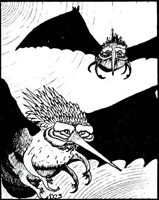 Both frost and fire giants, as portrayed in D&D, are loosely based on the jötunn of Norse myth. In the original myths, this was a rather vague term referring to a race of mostly (but not always) gigantic beings originally created by the primordial being Ymir. Ymir himself was certainly gigantic, since the sky is said to be the inside of his blue-coloured skull, and he was also described in the Prose Edda as "ice cold". Thus, while frost giants aren't a specific thing in Norse myth, it's clear where the idea comes from. Fire giants, apparently also descended from Ymir in the original myth, are the inhabitants of the fiery realm of Muspelheim, led by Surtur, whose primary function in the myths is to destroy the world at the conclusion of Ragnarok.
Both frost and fire giants, as portrayed in D&D, are loosely based on the jötunn of Norse myth. In the original myths, this was a rather vague term referring to a race of mostly (but not always) gigantic beings originally created by the primordial being Ymir. Ymir himself was certainly gigantic, since the sky is said to be the inside of his blue-coloured skull, and he was also described in the Prose Edda as "ice cold". Thus, while frost giants aren't a specific thing in Norse myth, it's clear where the idea comes from. Fire giants, apparently also descended from Ymir in the original myth, are the inhabitants of the fiery realm of Muspelheim, led by Surtur, whose primary function in the myths is to destroy the world at the conclusion of Ragnarok.Both frost and fire giants appear in a range of fictional sources, of which perhaps the most obvious are the Mighty Thor comics. These predate D&D by over ten years, although it's likely that their appearance in the game is an independent creation from the same mythic origin, since they're quite clearly different from the comicbook versions. In D&D, they are the third and fourth rungs on the six-step ladder of increasing giant power and strength and are portrayed as more technologically advanced than the smaller hill and stone giants.





